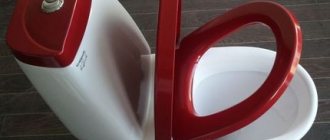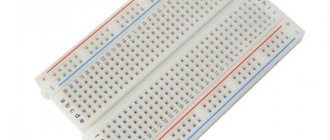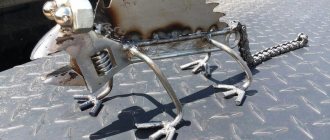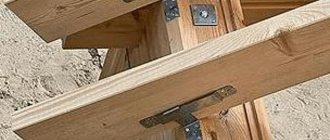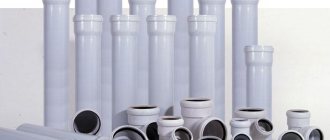From compressed air | 09/19/2017
Today, a hydraulic pallet truck or “rocla” (from the name of the Finnish company, developer and manufacturer of warehouse equipment) is an indispensable attribute of any warehouse, where all goods sold must be stored on pallets. Such devices are compact and easy to maneuver, do not require special training of operating personnel, and are easy to operate and maintain. The slang name “rocla”, which is now customary to designate all devices of a similar purpose, has already firmly entered the modern industrial lexicon.
What does it mean
Until the sixties of the twentieth century, loaders worked in warehouses, manually carrying and lifting heavy loads onto racks. Labor productivity was very low. It was impossible to quickly unload goods that weighed more than 1 ton. Therefore, at the end of the forties of the twentieth century, foreign companies invented and released the first models of rokhli, which quickly gained popularity all over the world. Today, large warehouses, industrial areas and shops are filled with devices of various modifications and manufacturers from different countries.
The global market presents equipment with a variety of functional features:
- • With low and high load capacity from 2 to 5 tons.
- • With small or large villas.
- • With single or double wheels.
- • Lifting with legs.
- • Electrically driven.
Recently, products with improved designs have been produced with electronic scales and label printers.
Hydraulic rokla or rokhla: what is the correct name?
In the sixties of the twentieth century, the name came from the Finnish company Rocla Oy. Models from this manufacturer began to arrive in the USSR and were sent to warehouses to help auxiliary workers, who found it easier and simpler to pronounce the word “rohlya” than “hydraulic trolley.”
Historical reference
Finnish manufacturers did not have time to produce the required number of fork carts, so the Soviet Union entered into contracts for the supply of equipment with Bulgaria. Until the collapse of the USSR (1991), Bulgarian, Skladova Tekhnika, Yantra, Simetro imported transporters.
In the early 90s of the last century, models from other countries, such as Denmark, England, Italy and Germany, began to arrive in the Russian Federation. But Russia had to abandon their goods due to the high cost.
At the beginning of the 21st century, major changes occurred in the world economy, and European companies had to replace the production of simple hydraulic carts with more high-tech units. And the production of old equipment was established in Asian countries where there is cheap labor. The PRC has also organized its own concerns. Therefore, the price of products varies greatly and depends on the supplier.
Forklift Brands Today
When choosing and purchasing equipment for loading goods, you should pay attention not only to the cost, but also to the country of manufacture. Defective products are often found when counterfeiting well-known European and American brands. But if the equipment passes the quality control department and is controlled by the shareholders of famous companies, then it reaches the market without complaints from buyers.
For example, the Chinese company Noblelift Equipment, together with the Americans, produces the NOBLIFT model, which will be much cheaper in cost than a similar product from the USA.
We will show you the percentage of transporters purchased by different manufacturers:
- • 20% of consumers purchase carts from China and other Asian countries, as they are attracted by the very low price. Grost is the most popular.
- • European models Lema Engineering, Otto-Kurtbach were in first place in demand (70%) due to high quality and low cost.
- • Famous products from world brands Rocla, Jungheinrich, Pfaff Motion, Yale, BT are available only to ten percent of consumers.
Where and how to apply
The transporter with a small carrying capacity has proven itself to be excellent for moving goods in large vehicles.
In the video we will show how rocla is used:
Advantages of warehouse equipment:
- • Use in all weather conditions. Rohlya is intended for work indoors and outdoors at air temperatures down to -50 degrees.
- • Low cost per product allows you to purchase equipment for any organization.
- • With proper use, the cart can last from 8 to 10 years.
- • Maintenance is simple and does not require special technical knowledge.
- • Problems can be corrected right at the workplace (no need for a specialized workshop).
- • The load capacity of the rokla is from 2 to 5 tons.
- • Thanks to its dual wheels, it can be used on uneven floor areas.
- • Small dimensions allow you to work in narrow corridors, small rooms, and vans where large technical equipment cannot reach.
- • With the help of a hydraulic system responsible for loading operations, even a woman will be able to operate the warehouse apparatus without the use of physical force.
How to operate an electric hoe
Accompanied carts are used quite often. Such carts are equipped only with a handle for manipulating the equipment. But there is another option - with a folding platform designed for the operator. It cannot be said that one or another option is better, for example, in management, because everything depends on the scope of application.
Handling the trolley does not require special training. After undergoing simple instructions, the employee will be able to direct the cart to the desired location, load it and then unload the delivered cargo.
This is achieved through ergonomic design and minimalist functions. Of course, a person should not have problems with coordination, because the self-propelled cart is capable of speeds of up to six kilometers per hour. And effective work in one area or another implies fairly rapid movement of goods.
In order for the electric weeder to fully comply with the declared characteristics during operation, it is important to take a responsible approach to choosing a store, as well as a manufacturer. It doesn’t hurt to read reviews about the model itself. Only in this case can you count on originality and a high level of quality.
What does the transporter consist of and how does it work?
The components are very simple and understandable to the average person:
- • Metal forks that lift and lower weights on pallets.
- • Handle for controlling the movement of equipment.
- • Single, paired wheels made of metal or polypropylene.
- • Foot or hand lever for raising and lowering the product.
- • Hydraulic apparatus consisting of a drive, a chrome-plated piston and an overload valve.
- • Lifting mechanism.
- • Foot or hand brakes.
The operating principle of the lifting device is similar to that of a conventional jack. It is necessary to pump the handle with smooth movements to raise the cart to the required height. Usually 6-7 movements are enough for this purpose. After this, the villas are raised to a maximum value of 0.22 m. This is enough to transport large bales over a short distance. All manipulations are performed using a pen. Also, the rotation of the villas depends on the lifting console located in the movable body of the lever device. It helps to grasp the load located in the transverse direction.
Modern technological processes have helped improve the design of the warehouse wagon. Now, with its help, you can find out the weight of the goods, change the center distance between the grips of the villas and tip over the products.
Operating principle and design of hydraulic raking
The operating element of a hydraulic loosening machine is a pump-based drive. The pressure it develops is transmitted through plungers to the working movable platform, which can move in the vertical direction. Less common are structures with combined movement of the platform - not only in height, but also along the opposite axis.
The plunger is controlled using a handle, the size and ergonomics of which determine the ease of use of the hydraulic breaker. The load is picked up by cantilever forks, which are also controlled by a hydraulic drive. The front wheels serve as the supporting surface for the forks, while the rear wheels are mechanically connected to the front ones. Lifting pallets with cargo from the floor surface is carried out as a result of successive swings of the pump, moving the forks upward.
Due to the fact that the lifting console is located in the movable lever body, the forks can be rotated at a certain angle. This ensures that the load is captured not only in the longitudinal, but also in the transverse directions.
Modern versions of the hydraulic trolley allow it to perform some additional functions, in particular, changing the center distance between the forks, weighing the load, and, if necessary, tipping it over.
Hydraulic breakers are classified according to the following performance indicators:
- By fork size (usually within 600...1800 mm, but designs with fork lengths of 3000 mm are available).
- According to the design of the working console and operating mode switch.
- By the presence of a brake. In the first case, hydraulic loosening can also be used on inclined surfaces.
- By load capacity. Conventionally, the structures under consideration are divided into small ones, with a load capacity of up to 1500 kg, medium ones - up to 2500 kg, and large ones - over 2500 kg.
- By lifting height (up to 200 mm) and extension of forks.
- The size and material of the wheels are steel, cast iron, aluminum or high-strength polyurethane. The front rollers are often double.
The choice of parameters depends on the conditions of use of the hydraulic breaker. For example, for maneuvering in a confined space of a warehouse or railway car, the unit may have forks of reduced length; on the contrary, when it is necessary to simultaneously grab two pallets with cargo, and the maneuvering area allows this, the forks can be longer.
Types of trolleys, rokla (rokla)
Conventionally, we can distinguish six groups of these products according to technical characteristics and tasks performed:
Classic
| General characteristics of standard products | |
| Length(cm) | From 110 to 280 |
| Height(cm) | from 108 to 125 |
| Width(cm) | from 53 to 58 |
The length is designed to work with a standard pallet and is 1.5 meters. For these reasons, the width was designed to be 0.54 m. The height of the handle (1.24 m) is suitable for the average height of a storekeeper and makes it easy to carry out all operations. The width of the fork runners does not exceed 16 centimeters, so they freely fit into the gap of the Euro pallet. Approximate weight – 80-90 kilograms.
Extended
There is a group of products whose linear dimensions required the creation of a transporter with deep forks. In this case, the length increased to two meters. This tool is convenient for gripping, for example, a stack of plywood. The width is kept the same to maintain versatility. Of course, the weight increased to 120 kg.
Shortened
The parameters remain the same, only the fork reach is 80 centimeters. This dramatically increases maneuverability, making them suitable for use in tight warehouse spaces. Accordingly, the weight of the product has decreased by 20 kg.
Low profile
There are non-standard clearances under the lifted load, which is necessary to save space in the warehouse. In this case, trolleys with a minimum fork lowering of up to 5.5 centimeters are used. The remaining parameters remain standard. It is worth noting that such equipment is more critical to the quality of the floor surface.
Electrical
Luggage is placed on shelves at a specific storage location. For this purpose, carts with scissor lift are produced, the maximum height of which is up to 80 centimeters. To reduce physical activity, such models are often equipped with an electric drive, which helps to move without the use of force at speeds of up to 6 km per hour.
Specialized
Manufacturers of transporters offer the device with additional options. For example, electronic scales that weigh luggage with an error of up to half a kilogram. Another example is a barrel carrier equipped with a device for gripping and holding standard 200-liter containers.
| Name | Rotator for barrels | Barrel tipper | Tipper with lift |
| Model | DT250 | HD80A | DA40B |
| Description | Specialized up to 210 liters; | With tipping function – 210 l. | Lift function to a height of 1.35 meters. |
| Gr. lifting capacity in kilograms | 250 | 364 | 400 |
| Size(cm) | 57,2 | 57,2 | 57,2 |
| Trolley weight (kg) | 42 | 50 | 190 |
Recently, companies have begun to equip warehouse equipment with high-tech devices: a barcode scanner and a router. This greatly simplifies indoor logistics.
Features of operation
The key component of any trolley is the hydraulic system. The hydraulics are driven by a pump. The pump's job is to provide a given level of air pressure. The hydraulic drive is located on a moving platform. The platform is controlled by a rotary handle.
The pallet is grabbed with a fork. Lever-type corner consoles are used to connect elements to the hydraulic unit. Most of the lifters produced today by warehouse equipment manufacturers capture loads in both the longitudinal and transverse directions.
One of the important advantages of rokla is considered to be a simple and understandable principle of operation. First, the forks of the trolley are rolled under the pallet, after which the grip is performed. Then the load is transported to the required distance and removed. The lift-to-height function greatly simplifies the installation of products on racks.
Characteristics (weight, load capacity, fork length, lifting height)
For different warehouses and different conditions of use, the design of the device should be different. Most of them can be stored and moved by a classic-looking transporter.
The dimensions and weight of the raft, depending on the manufacturer, may differ in terms of load capacity and wheel diameter.
| Load capacity | T | 2,5 |
| Platform length | m | 1,15 |
| Width | m | 0,55 |
| Platform height | m | 0,2 |
| Number of wheels | PC | 2/2 |
| Rear wheel diameter | cm | 20 |
| Roller diameter | cm | 8 |
Dimensions
To handle larger luggage, an extended trolley is available. It is distinguished from the first by a fork length of up to 2 meters and an increased weight of up to 3 tons.
Lifting height
The norm is a maximum distance between the floor and the top of the platform of 22 centimeters. This parameter allows you to move standardized pallets smoothly, preventing goods from tipping over. There are models with a minimum lowering of up to 0.055 m. Typically, the clearance under the pallet should be 8 cm. A special type are devices with a scissor lift, which allow you to raise the container by eighty centimeters. This makes it easier to move parts. This type of transporter is often used in production.
Fork length
In tight spaces, if the dimensions allow, it is convenient to use a cart - 0.8 meters. This product has a smaller turning radius and is lightweight. In this case, the maximum liftable load should be no more than 500 kilograms.
Load capacity
This function depends on the power of the jack, on the ability to withstand the loads of the entire mechanical structure (fork rigidity, thickness and strength of rod parts, correctly selected rollers).
Weight
Modern products compare favorably with their predecessors. Due to the use of high-quality steels and the correct fit of all components of the mechanisms, the weight has been significantly reduced. This reduced the workload on employees, and performance was not affected.
Features of hydraulic trolley
Depending on the tasks performed, it is often necessary to equip the tool with consumables - wheels. During merciless operation in production areas with uneven floor surfaces (cracks and potholes in asphalt, concrete), roller bearings and wheel tires often fail. After just a year, they have to be repaired or completely replaced.
The material used to cover the wheel rim is made from:
- • Made of rubber. Carts with such rollers move well and silently over lumpy floors, without slipping on the tiles. They are not afraid of liquid spilled on the surface, such as water, methyl alcohol, denatured alcohol. Withstands negative temperatures. Rubber tires cover rims made of steel or aluminum.
- • Made of nylon. Wheels made of this material hold large loads well. The downside is poor cross-country ability on uneven roads. Hydraulic conveyors with such rollers are supplied to food and pharmaceutical industries, as they are not afraid of aggressive chemical compounds (alkaline and acid solutions, various solvents, oils, salt and ammonia).
- • Made of polyurethane. These wheels are famous for their durability; they last four times longer than the ones listed above. Do not be afraid of the aggressive effects of chemicals.
Replacing worn rollers and wheels is no problem. After this procedure, your baby will last for a long time. You can find the entire range of necessary products on the website of the trading and production company MPlast.
The equipment is equipped with:
- • Brake systems. Operation showed the need to immobilize the wheels. This is important if the surface of the warehouse has a slope. Many modern models are equipped with a rolling stop device. The control handle can be located either on the handle or below, next to the rotary wheels.
- • Product weight meters. A very useful option that allows you to significantly reduce the time a storekeeper spends on accounting.
- • Retractable forks. In some cases, it is necessary to lift weights not from the floor, but from a certain height. A simple device greatly facilitates the work of loaders and installers.
- • Lifts. Engineers have developed lifters capable of not only moving, but also lifting containers with products to a height of up to 80 centimeters.
Hydraulic diagram of the rover
The hydraulic system control device is a pump and a three-position plunger stroke switch built into the handle (up, down, neutral). For heavy-duty hydraulic trolleys, the drive can be foot driven.
The handle is usually rubber-lined, spring-loaded, and self-adjusting to specific operating conditions. The pump body is manufactured using precision casting methods, which minimizes possible leakage of hydraulic fluid. The actuator element of the hydraulic drive - the piston - is made of high-quality structural steel, undergoes hardening heat treatment and has a protective chrome coating. The plunger is protected from contamination of the gaps by a hinged cover, which protects the surface of the plunger rod from condensation if the hydraulic breaker is operated alternately, indoors and outdoors. The hydraulic drive is protected from overload by a safety valve.
The hydraulic circuit of the ram works like this. The forks are inserted into the gap between the surface and the bottom of the pallet. When the handle swings, the piston begins to supply working fluid to the lower part of the cylinder, causing the rod with the plunger to rise upward. During the reverse stroke, the flow of liquid into the cylinder is prevented by a safety valve, which is activated only when the forks are overloaded by the tipping moment. Upon reaching the required height of the pallet with cargo, the hydraulic drive control handle is moved to the neutral position, after which the load can be rolled in the required direction. The pan is lowered by turning off the control valve, which causes the liquid to drain into the tank, or (for three-position switches) by turning the handle in the “down” direction. The forks are lowered and the hydraulic lifting trolley is moved out from under the lower plane of the pallet.
To maintain the hydraulic drive of the rotor in constant operation, the rear and front rollers, as well as the plunger rod, should be periodically lubricated using a grease nipple.
The reliability of the use of weeds is ensured by compliance with certain mandatory rules:
- The device must not be loaded with more than rated force.
- The load should be evenly distributed between both grips: this eliminates their possible deformation.
- Dust, dirt, and small objects should not get into the bearing units of the rollers.
- The dimensions of the space in which the lifter operates must be correctly correlated with the dimensions of the room where the pallets with cargo are located.
- Pumping the working fluid into the hydraulic cylinder should be done with the full range of movement of the handle.
- To prevent wear of the wheels, you should prevent the roller from moving on uneven, dirty and rough floors (especially for plastic rollers).
How to choose a hydraulic pallet truck
To make a decision on choosing a product, you need to decide on the tasks that need to be performed. You need to understand under what conditions and how intensively it will be used, what maximum weight needs to be moved. Should you spend money on improved models with additional options, such as electronic scales and a barcode scanner?
Rules of care and operation
According to the technical data sheet, the service life of warehouse equipment is from three to five years. But if you care for it properly, it will work much longer.
Our recommendations:
- • Do not overload the cart. The weight of the product must correspond to the stated data in the document.
- • Distribute the mass evenly on the forks (do not lift goods at the tips of the platform).
- • Inspect the undercarriage daily. Remove objects that fall on the wheels (wire, threads, leaves, tree branches).
- • To maintain the working condition during movement, it is necessary to lift the forks by pressing the lever, which is required according to the technical specifications.
- • There is a rule: you should pull the rokla along with you. Pushing yourself in front of you is prohibited.
- • Inflation should occur as written in the instructions, from the starting point to the stop. Otherwise the node will fail.
- • Before purchasing equipment, pay attention to the condition of your floor. If the surface is deformed, the wheels of the standard model will quickly break.
- • Watch the oil level in the hydraulic unit. Avoid leakage. Change the lubricant in a timely manner.
- • If air has entered the hydraulic system, it must be removed by pressing the handle without loaded trays.
How does a hydraulic trolley work?
A hydraulic trolley (or trolley) is a compact and maneuverable U-shaped device used in warehouses, which has:
- Double-pronged forks with support wheels and rollers.
- Hydraulic unit connected to forks. In the process of operation of the ram, the base, discharge and working cylinders, a metal rod (transmits force to the traction of the trolley), a plunger (pumps oil into the working cylinder), a ball valve, a conical valve (with a spring and a lever), a valve plunger, O-rings and a spring take part .
- A handle with a control lever for raising and lowering loads placed on pallets.
The pump is controlled by switching up, down and neutral. By moving the handle, the liquid in the cylinder is filled, the rod and the load on the forks are raised. A neutral position is established when transporting goods. When lowering it down, the working cylinder is emptied and the forks move to the lower position.
The simple design of this technical tool does not require special knowledge and skills for its use: the forks are placed under the product, and then it is transported to the desired location. Also, a number of modern models contain functions such as adjusting the distance between the forks, determining the weight of the goods, and more.
Price
First of all, the price of the equipment depends on the load-carrying capacity of the product and the length of the platform. Often the cost is inflated by the manufacturers themselves and the product does not justify the functional characteristics of the product. Therefore, it is worth paying attention to the price-quality ratio.
In our article, we clearly showed in photographs what a trolley or hydraulic trolley means, and told how much it weighs and how to care for it. To better understand how the equipment works, watch the video:

